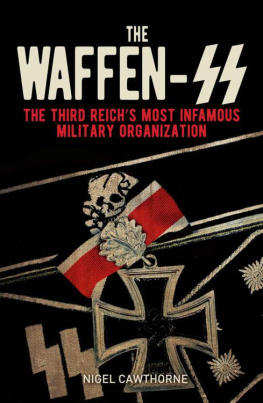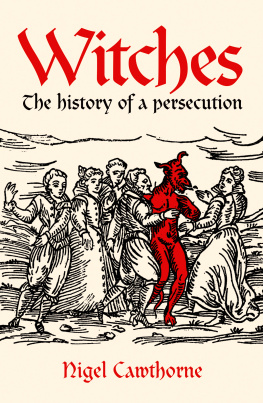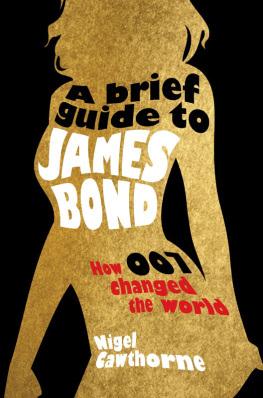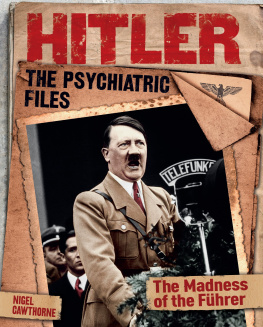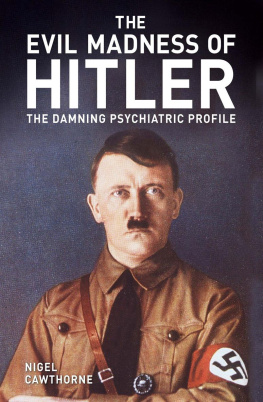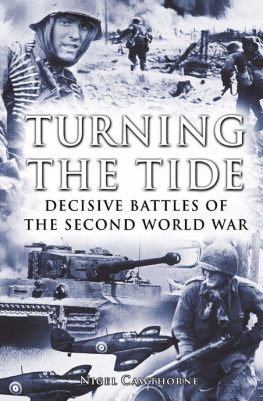Nigel Cawthorne - The Waffen-SS
Here you can read online Nigel Cawthorne - The Waffen-SS full text of the book (entire story) in english for free. Download pdf and epub, get meaning, cover and reviews about this ebook. year: 2022, publisher: Arcturus Publishing, genre: Non-fiction. Description of the work, (preface) as well as reviews are available. Best literature library LitArk.com created for fans of good reading and offers a wide selection of genres:
Romance novel
Science fiction
Adventure
Detective
Science
History
Home and family
Prose
Art
Politics
Computer
Non-fiction
Religion
Business
Children
Humor
Choose a favorite category and find really read worthwhile books. Enjoy immersion in the world of imagination, feel the emotions of the characters or learn something new for yourself, make an fascinating discovery.
- Book:The Waffen-SS
- Author:
- Publisher:Arcturus Publishing
- Genre:
- Year:2022
- Rating:5 / 5
- Favourites:Add to favourites
- Your mark:
- 100
- 1
- 2
- 3
- 4
- 5
The Waffen-SS: summary, description and annotation
We offer to read an annotation, description, summary or preface (depends on what the author of the book "The Waffen-SS" wrote himself). If you haven't found the necessary information about the book — write in the comments, we will try to find it.
The Waffen-SS — read online for free the complete book (whole text) full work
Below is the text of the book, divided by pages. System saving the place of the last page read, allows you to conveniently read the book "The Waffen-SS" online for free, without having to search again every time where you left off. Put a bookmark, and you can go to the page where you finished reading at any time.
Font size:
Interval:
Bookmark:

Contents
Introduction
The Waffen-SS was the private army of Adolf Hitler, who had become the brutal dictator of Germany in 1934. It started out as part of his personal Protection Squad, the Schutzstaffel ,or SS, which defended him from political opponents. Once Hitler took power, it was armed and were organized along the lines of the German armed forces, the Wehrmacht .
When Germany went to war, the Waffen-SS found itself in the forefront of the fighting in Poland, the Low Countries, France and Russia. Hitler depended on it because of its members personal loyalty to him. He had always distrusted the army. The commitment to Nazi ideology of the Waffen-SS made its members formidable fighters. They were told that they were the spearhead of a master race that could not fail. Even their enemies among the Allies recognized even admired their fighting abilities.
Their belief in Nazism led Waffen-SS men to commit numerous atrocities. To them, Jews were subhumans who needed to be exterminated, while Slavs were fit only to be robbed and enslaved. Neither pity nor empathy would stand in their way. Communism was an alien creed fostered in the East. It was the duty of the Waffen-SS to defend European civilization from it. However, that was not the way the rest of the world saw it.
In the end, fanatical belief in a cause was not enough. Though better equipped, the Waffen-SS was relatively small compared to the German army which itself was outmanned by the numbers the Russians could muster in the East and the Anglo-Americans could deploy in the West.
Inevitably, the Nazi fanatics were culled by casualties and Waffen-SS units were diluted by those not quite so committed to what proved to be a losing cause. But even when Germanys defeat seemed certain, the Waffen-SS fought on. And its fidelity to Nazism did not end with the war. Following Germanys defeat and Hitlers suicide in 1945, attempts were made to set up Werwolf sleeper cells. These failed. At the war crimes trials held in Nuremberg, the Waffen-SS was declared a criminal organization, along with the SS itself. Many of its leaders were tried as war criminals. Others committed suicide or escaped, largely to South America.
In the 1950s, the Mutual Aid Association of Former Waffen-SS Members, or HIAG, sought to rehabilitate the reputation of the Waffen-SS , maintaining that its members were merely soldiers like any other. They werent. The Waffen-SS men were the spear carriers of one of the most evil regimes in history. They may have been valiant on the battlefield, but they were committed Nazis, blindly loyal to Hitler and his murderous ideology. Thankfully, the Waffen-SS has been expunged from history, but its story should chill the blood of anyone who enjoys the twin luxuries of peace and freedom.
Chapter One
The Formation of the Armed SS
When Adolf Hitler took the oath of office as Chancellor, administered by the President of the German Republic Field Marshal Paul von Hindenburg on 30 January 1933, his position was far from secure. Despite a torchlit march through Berlin by thousands of Nazis, he was surrounded by enemies. While the Nazi Party was the largest party in Germany, it only had three members in the coalition cabinet formed with the German National Peoples Party and the nationalists still had an independent paramilitary force the Stahlhelm or Steel Helmet. Hitler was going to change that. He was just 44 years old at the time.
Born in Austria in 1889, Hitler had aspired to be an artist before becoming a down and out in Vienna. Avoiding conscription into the Austrian Army, he moved to Germany in 1913, but joined the German Army at the outbreak of World War I the following year, only rising to the rank of corporal. Following Germanys defeat in 1918, many ex-servicemen blamed Berlins capitulation on the duplicity of the civilian population, particularly Communists and Jews.
They also blamed the ensuing economic chaos on the peace treaty drawn up in Versailles, ending the war. This demanded unpayable reparations that caused rampant inflation in Germany. On top of that came the Wall Street Crash, which threw the whole world into economic depression. The Versailles Treaty also stripped Germany of territory as the map of Europe was redrawn by the victors. The industrial Rhineland was occupied and strict limits were put on the size and strength of Germanys armed forces. The result was political as well as economic chaos.
Many on the left sought to emulate the Bolshevik Revolution that had taken place in Russia in 1917. German ex-servicemen formed Freikorps (Free Corps) to fight the Communists. These paramilitary units received considerable support from the German government, which also feared a Communist uprising. The Freikorps and the Communists fought it out on the streets. However, they fell out with the government after a failed putsch in 1920.
Myriad small political parties sprang up. One of them was the German Workers Party or DAP. Hitler joined. A gifted orator, he quickly took over, renaming it the National Socialist German Workers Party (in German Nationalsozialistische Deutsche Arbeiterpartei , or NSDAP). It was more commonly known as the Nazi Party. Needing protection from political rivals, the Nazi Party formed the paramilitary Sturmabteilung (SA), whose members were known as Stormtroopers or brown-shirts. An inner corps was formed as Hitlers personal bodyguard. This became Hitlers personal Protection Squad, the Schutzstaffel or SS, who would soon become easily identifiable by their sinister black uniforms. It was established in 1925, after the SA was temporarily banned following Hitlers failed Beer Hall Putsch, an attempted coup detat in Munich in 1923. The leader of the SS was a puny chicken farmer named Heinrich Himmler who went on to become the architect of the Holocaust. Along the way, Hitler became a German citizen and ran for office.
With its paramilitary organization, the Nazi Party became a considerable political force. In the election of July 1932, it won 37 per cent of the vote. But Hitler refused to join a coalition and the government fell. In an election that November, the Nazi Party lost 34 seats in the Reichstag, or German parliament, while the Communists gained 11, taking them to 89 seats, while the Socialists had 133.
With Nazi popularity seemingly on the wane, Hitler this time agreed to join a coalition as Chancellor. The other party leaders were happy with this arrangement as they thought they would be able to control a man they considered a political novice. They were wrong. After another election, Hitler made himself dictator. When von Hindenburg died on 2 August 1934, Hitler combined the offices of Chancellor and President, making himself the undisputed Fhrer , or leader.
Meanwhile, Hitlers rival in the National Socialist German Workers Party, Ernst Rhm, head of the brown-shirted Sturmabteilung (SA), or Storm Battalion, was seeking a second revolution which sought to overthrow capitalism and take over the Reichswehr , Germanys small defence force permitted under the Versailles Treaty. The Reichswehr itself was also hungry for political power.
ARMED PROTECTION
Hitler needed protection armed protection from his enemies, particularly the two million members of the SA, which had 20 times the manpower of the Reichswehr . However, within the SA, there were ultra-loyal black-uniformed Schutzstaffel (SS) men who were dedicated only to Hitler. On 17 March 1933, the 120-strong Berlin SS-Stabswache , under Josef Sepp Dietrich, an artillery sergeant who had served in a newly formed tank unit at the end of World War I, replaced the Reichswehr as guards inside the Reich Chancellery at the Palais Schulenburg at Wilhelmstrasse 77, after Hitler moved there from his headquarters in the Hotel Kaiserhof. The Army was not overly worried about this move. It dismissed the Stabswache as asphalt soldiers, good for nothing but ceremonial duties.
Next pageFont size:
Interval:
Bookmark:
Similar books «The Waffen-SS»
Look at similar books to The Waffen-SS. We have selected literature similar in name and meaning in the hope of providing readers with more options to find new, interesting, not yet read works.
Discussion, reviews of the book The Waffen-SS and just readers' own opinions. Leave your comments, write what you think about the work, its meaning or the main characters. Specify what exactly you liked and what you didn't like, and why you think so.

